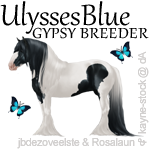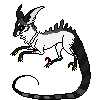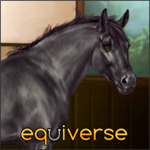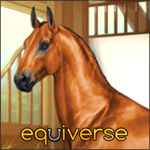  Adding Colors and Markings to Breeds Adding Colors and Markings to Breeds |
|
#41635 Posted on 2016-05-28 03:58:24
I've been thinking about sooty a bit more, and based on my own observations this is my hypothesis (just mine, not that of some geneticist or horse expert, so take it with a grain of salt):
What we're seeing seems to be two entirely different sooty phenotypes:
- The topline type of sooty, which adds black hairs into the coat, concentrated along the topline of the horse, and getting less concentrated going down. This often forms dapples, but not always.
- The uniform type of sooty, which uniformly darkens the entire coat, resulting in things like liver chestnuts, etc.
For clarity I'll term the topline type as sooty (STY), since this is what we call it on EV, and the uniform type as darkening (dk), since this is the name proposed in the German study I mentioned earlier.
In the study, they looked at both bays and chestnuts, so it clearly acts on both, and they found that by studying pedigrees and photos the darkest shades seemed to follow a recessive mode of inheritance, so probably something like this:
NN = normal shade
Ndk = normal shade OR slightly darker?
dkdk = very dark
I'm not sure how we could expect this to behave on black based coats. I would expect either it does nothing, or it's subtle enough that it's not readily noticeable.
Separate to this is STY, which distributes black hair along the topline. Since this is actual black, I suspect it would be affected by the Extension locus. 'ee' prevents a horse from having black hair (i.e. it's chestnut) so I suspect that this would also prevent this type of sooty from showing up on chestnut based coats, which would explain why I can't seem to find any examples of the topline type sooty on chestnuts or palominos, even though finding evidence of it on bays and buckskins is easy. On a black coat I expect it does nothing, as the gene is essentially telling the coat to have black hair in a spot that already has black hair. I suspect it is also affected by the dilution genes in the normal manner. Genetically you'd probably have something like this:
stysty = no sooty
STYsty = moderate sooty
STYSTY = extensive sooty
I wouldn't be surprised if there are additional genes which further affect the strength of these sooty or darkening genes. I can also see merit to the hypothesis that seal brown is actually a very extensive sooty bay. Certainly a lot of horses I've seen which have been phenotypically identified as seal brown show some clear characteristics of sooty.
3 members like this post.
|
Posted By

UlyssesBlue
#60734
 
Member is Offline
922 forum posts
Send A Message
|
|
#42439 Posted on 2016-05-30 13:10:45
Modified the form to fit my needs...
Gene: Dun
Suggestion: Instead of d, eventually introduce the two recessive forms nd1 and nd2.
Function: The dominant D both dilutes and adds primitive markings. Always a crisp, bold dorsal stripe; commonly leg bars, shoulder stripes/mottling, ear tips, face mask, and sometimes mane frosting. The recessive nd1 (dominant to nd2) typically does not dilute (if it does, it is very little) and may or may not add primitive markings. Recessive nd2 neither dilutes nor adds primitives, it serves the function of our current d.
Relevance: Some breeds have the dominant D (Quarter Horses, Paints, Mustangs, etc.). However, other breeds do not have the dominant allele and are often confused for being dun when they are not, they are likely nd1 (Andalusians, Chincoteagues, etc.).
Proof of Existence: UC Davis zygosity test (reputable lab, references at the bottom of the page), Article.
Below: red dun D/- (left) and non-dun red likely nd1/- (right)
The horse on the left definitely has a D allele. I unfortunately do not know the genotype of the horse on the right, but his color is comparable to a tested homozygous nd1/nd1 mare I've seen (no good photos of her, though I could ask her owner) and is only used for comparison purposes.
 
Breed: Thoroughbred (you'd expect anything else from me?)
Suggestion: Sooty and flaxen
Proof of Existence: As stated in a previous post of mine, sooty is not a catch-all in terms of phenotype/appearance. There are many different types of expression. Even then, sooty horses can change color as they shed coat and age. A foal can start out very light and end up super dark, and a foal can also go through many color changes as it grows up, ending up looking like it isn't sooty, but from timeline photos obviously is.
Cassie's Goldlocket, a sooty palomino Jockey Club registered Thoroughbred mare. She started out looking very pale in color, shedded out darker, and faded into adulthood (cannot find still pictures of her nowadays, but a video I found shows her looking like a typical palomino with what appears to be a faint reminder of her yearling sooty shade).
Right of Light, a flaxen chestnut Jockey Club registered (name released; deceased) Thoroughbred stallion.
 
These genes are not under dispute by the common man, scientific community, or the Jockey Club (the registry just doesn't label colors properly).
3 members like this post.

|
Posted By

vos
#32898
 
Member is Offline
728 forum posts
Send A Message
|
|
#53044 Posted on 2016-07-15 14:59:13
Heh, I just came here to suggest flaxen in TBs, but I see there's no need.
That trotting mare looks darn near identical to a pair of Morgans a friend of mine bred (real ones, I mean). Full sisters and neither parent looked anything like them. Very curious. Also not really relevant, the pic just made me think of them. :)
Last edited on 2016-07-15 at 14:59:37 by Rising Dawn
0 members like this post.
|
Posted By

Rising Dawn
#53794

Member is Offline
465 forum posts
Send A Message
|
|
#53052 Posted on 2016-07-15 15:31:12
Breed: Trakehners
Color:
Marking: Splash
Proof it exists on purebred horses of that breed: Splash (HOMO SW1) Tested Foal | Paper that talks about Splash and mentions it is found in Trakehners.
Is it disputed by a reputable source? As far as I know, no.
2 members like this post.

|
Posted By

marmist »
#28206

Member is Offline
106 forum posts
Send A Message
|
|
#62721 Posted on 2016-08-22 18:40:44
Breed: Thoroughbred
Color: Grey
Marking: Dappled
Proof it exists on purebred horses of that breed: (e.g. links to studies, to a widely known registry which states it's accepted, etc.)
https://www.registry.jockeyclub.com/registry.cfm?page=dotRegistryIdentifyThoroughbred
Is it disputed by a reputable source?
Nope :)
1 members like this post.
|
Posted By

Underhill Stables
#68327

Member is Offline
115 forum posts
Send A Message
|
|
#62935 Posted on 2016-08-23 22:13:48
Breed: Akhal-Teke
Color: Flaxen (Chestnut)
Marking: ^^
Proof it exists on purebred horses of that breed: Ashamaz
Is it disputed by a reputable source?: No.
The website owner states that all horses sold through his site have a MAAK passport and are registered in the general studbook. Now, I've never seen a flaxen teke before, but both MAAK and ATAA state that basically all colors are accepted. While the ATAA gives a mini genetics lesson, it says nothing of the flaxen gene. ATAA's blanket statement for teke coloring: "Few breeds of horse can claim the diversity of coloration to be found in the Akhal-Teke. They have 3 main basecoat colors: Black, Bay, and Red that along with a many color modifiers lead to stunning variations." which is terribly general.
MAAK, however, states that "A feature of the breed is its great variety and gradation of colours, particularly golden...The commonest colours are: bay (39.9%), dun (22.4%), black (l2.3%), chestnut (ll.2%), gray, light bay and cream are less frequently encountered." For some reason I can't find it again, but somewhere on MAAK's website it states that Akhal-Tekes are registered by parentage only, which is why there isn't a color standard.
In my personal, amateur opinion, that filly's color is flat and she isn't fantastically typical, but she definitely looks like a teke. The website owner seems to take pride in the quality of animals he sells and the authenticity of the information. There are no pictures of that filly's parents, it only says they're palominos, so no judgements there. I found Khalid on allbreedpedigree.com, but there's no picture. Same with the dam, Asida. Khalid's pedigree, is, however, all filled out, and Asida's only goes back one generation. The studbook's been around long enough that I assume somebody just didn't feel like filling it out. Asida's pedigree is listed on Ashamaz's page, and I've definitely seen some of those names on other horses. So...yes. There's my evidence. One, unattractive, flat-coated filly. Ta-dah.
0 members like this post.
|
Posted By

Celtia
#17608
Member is Offline
3 forum posts
Send A Message
|
|
#63203 Posted on 2016-08-25 03:56:39
^ I think that filly may be simply palomino, not flaxen. Her colour is listed as palomino on that page, and both parents are also palomino, so her pedigree supports that theory. Her colouring with the red body and pale mane/tail is also consistent with the darker reddish shades of palomino.
0 members like this post.
|
Posted By

UlyssesBlue (spare)
#75110
 
Member is Offline
559 forum posts
Send A Message
|
|
#63215 Posted on 2016-08-25 06:46:29
Yes, both her sire and dam are palominos. She's palomino as well. Registries and such are ignorant when it comes to color. Case and point, including dun in common colors. Akhal Tekes do not have the dun dilution.
0 members like this post.

|
Posted By

vos
#32898
 
Member is Offline
728 forum posts
Send A Message
|
|
#63220 Posted on 2016-08-25 08:32:28
I just feel the need to express that this entire thread is awesome: 1) Getting needed genes into the game. 2) Pretty pony pics for me to look at. 3) It's been ridiculously educational for me and I love reading the debates. Anyway.
0 members like this post.

|
Posted By

Owlshine 🦉
#99975

Member is Offline
470 forum posts
Send A Message
|
|
#70276 Posted on 2016-09-29 18:39:37
Breed: Thoroughbred
Color: seal brown
Marking: n/a
Proof it exists on purebred horses of that breed: Ruffian Images; Seattle Slew Images
Even though both are listed as "dark bay or brown", they look seal brown to me!
And they're both champion racehorses, so they're true TBs.
Unfortunately, I haven't been able to get a better source yet.
Is it disputed by a reputable source?: Not really.
Last edited on 2016-09-29 at 18:46:28 by Raptorfang™Ω
1 members like this post.
|
Posted By

Raptor
#79219
    
Member is Offline
7244 forum posts
Send A Message
|
|
#74832 Posted on 2016-11-06 23:15:35
Breed: Andalusian
Color: Grey-Black
Marking: Little spots all over body. Most dominant around the back, hips, and neck.
The color can shade. Sometimes it can be white with little outlines of grey dots spread all over the body, sometimes it can be black with grey/white outlines of dots. Here are some pics.I labeled the horses with numbers. Number1. is a black/smokey gray dapple. He mostly has dapples around his neck and upper back. He is considered dark dapple. Number2. Is a greyish whitish color with very light grey dapples. They are almost hard to see. Number2. is considered a Light Dapple. Number3. has grey and white mixing and making a shade of grey which is light but the dapples are very easy to see. This is considered a Middle Dapple. Number4. has a very dark coat with noticeable dapples. This is considered Black Dapple.
1.
2.
3.
4.
Last edited on 2016-11-06 at 23:54:23 by ~Star Shine Stables~
1 members like this post.
|
Posted By
Luminescent
#106133
 
Member is Offline
924 forum posts
Send A Message
|
|
#74834 Posted on 2016-11-06 23:38:39
^ Images 1-3 appear to be dapple grey, and image 4 is a silver dapple rocky mountain horse (source). This is a black base coat with silver. Andalusians can already have both grey and silver dapple over a black base coat, and has art for these. The existing art doesn't seem to include dapple grey, but has other grey varieties. It would be nice to get more grey varieties though (for all breeds). Dapple is one of the prettier ones.
2 members like this post.
|
Posted By

UlyssesBlue (spare)
#75110
 
Member is Offline
559 forum posts
Send A Message
|
|
#74835 Posted on 2016-11-06 23:50:11
I agree. I was very tired when I wrote that. sorry
0 members like this post.
|
Posted By
Luminescent
#106133
 
Member is Offline
924 forum posts
Send A Message
|
|
#77138 Posted on 2016-11-27 00:54:52
Breed: Morgan
Marking: Splash
Proof it exists on purebred horses of that breed:
http://www.morgancolors.com/splashwhite.htm
https://en.wikipedia.org/wiki/Splashed_white
https://www.morganhorse.com/upload/photos/904TMH_June2015_WhiteHot.pdf
the horses
I couldn't find his original breeders page due to page after page of him being spread through through pinterest, but here's a look at him and his name
Marvelous Picasso- http://colourfulequines.tumblr.com/post/26543246084/marvelous-picasso-a-rare-splash-white-morgan
MEMC on Target- http://www.selectbreeders.com/news/101
possible splash-
http://www.stonelakemorgans.com/
Is it disputed by a reputable source?
I can't find any myself. It is pretty new information to Morgan breeders but genetics favor the Splash side.
However, splash for Morgans is quite minimal and usually only effects with small markings and eyes. The large dominate markings are more like the minor markings in the game. I've only shown horses with dominate markings.
(I'm bad at this find sources things. Google won't give me anything besides pinterest)
2 members like this post.
|
Posted By
Crimson Wolf
#104363
Member is Offline
53 forum posts
Send A Message
|
|
#78724 Posted on 2016-12-09 01:46:22
Well KWPN has crème genes. Currently those are very popular. I am on my phone now so I can't link to anything yet
0 members like this post.

|
Posted By

megansparrow
#45453

Member is Offline
426 forum posts
Send A Message
|
|
























